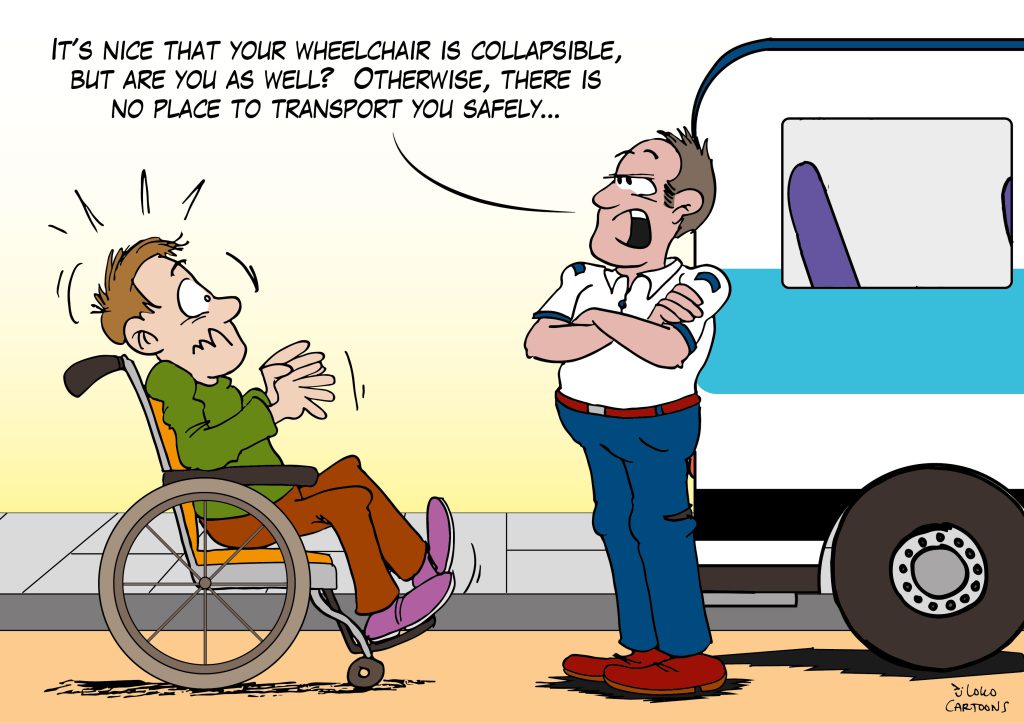It causes damage!

As a long time interested (retired) researcher on transport of people with a handicap, I experience more and more the amount of real life circumstances that I cannot be aware of.
Read More »
Op zoek naar veilig vervoer voor rolstoel gebruikers

As a long time interested (retired) researcher on transport of people with a handicap, I experience more and more the amount of real life circumstances that I cannot be aware of.
Read More »18 December 2023 Roelof Veenbaas in Magazine Personenvervoer 6.23 p 16/17
“May your choices reflect your hopes, not your fears” Nelson Mandela
The pupils transport crisis is a complex problem that tolerates single solutions badly. The characteristic of complex problems is that no one, including me, has a complete picture of the whole of reality. On the other hand, people (especially people around the workplace) are most aware of this complexity and often best equipped to deal with it. By identifying risks and trying to prevent calamities. That is, if they are given the space to do so! As Todd Conklin, Senior Organizational and Safety Culture Advisor, points out, “We need to keep talking about risk!”
This requires to look critically at one’s own role continuously, questioning the other openly about their image of reality and taking signals seriously. We can start doing that now by deepening the adage “A lot is going well!” What is going well where? What can we learn? Built on the work of giants like Conklin, that’s why I’m writing this opinion on the driver crisis in pupils transport to and from school.
What do we actually mean by Quality in the sector?
This contribution was published as an Opinion article in PV Magazine 6 on December 23, 2022,
see also PV magazine. The illustrations are from the film Crisis in het leerlingenvervoer
In the Covid period, contract transport has fallen sharply. Now there is a follow-up problem: a chronic shortage of drivers. Drivers have found other work or have stopped. There are companies that have managed to retain their drivers with arts and crafts, with lending and reducing working hours and other creative solutions.
A study by Ouders en Onderwijs (O&O) and tweets by Elijah Delsink of the student interest (LBVSO) shows that the shortage of drivers now causes student transport to run dramatically in a number of places. There are fewer fixed trips and regular drivers. Companies sometimes bring students to school in two shifts, causing students to arrive late to school. Or they are not picked up at all. Because parents take care of this, they miss working hours and this has consequences for their job! Important teaching hours, tests, are missed. That damages students. Good education is at risk.
Read More »
After starting my website with ideas about safe wheelchair transport, it is time to step aside to think about the future. How can I use my experience and knowledge to help those involved in transport? Is the branche, but much more important, are drivers and customers waiting for that?
How can safety in the wheelchair taxi sector be shaped differently, more from the experience of drivers, passengers and wheelchair manufacturers? Invest in what’s going well.
In order, as a wheelchair user, to be able to function as optimally as possible functional requirements are drawn up for each wheelchair provision, which a wheelchair should meet. An inappropriate wheelchair can have major consequences for the physical condition of the user and therefore in education, being able to work, sports and other daily activities.
Therefore, in many cases these requirements are drawn up together with an occupational therapist. It may mean that a standard factory wheelchair needs to be adapted to meet the requirements package, or even providing a custom wheelchair fully individually adapted to one wheelchair user.
Around the turn of the year it is customary to look back at what has happened in the past year and what the perspective for the coming year may be.
Read More »International literature shows that the strength of a wheelchair (the impact test) is not the most important for safe transport. The correct use of seat belts and restraint systems in combination with the wheelchair and the (unique) occupant are at least equally important. Safety problems in wheelchair (taxi) transport require a joint approach all involved parties. Looking from the risk perspective of the wheelchair occupant and his / her transport environment.
Read More »The following letter was sent to the authors of the Code VVR and parties involved in the transport and wheelchair provision. Because there are currently two Codes I use the term Code VVR (SFM) here. The code was published by Social Mobility Fund as secretariat on behalf of the Platform.
For me, safety and cooperation in the workplace are particularly important in the provision of wheelchairs and in transport.
In order to improve the safety of wheelchair transport, the Netherlands has a long tradition. Including a Code VVR, which contains rules that the various interested parties should adhere to. There are currently two VVR codes coexisting. 1: the successor to the Code VVR from 1999, registered and maintained by Ap Peters (Code VVR A. Peters).
2: a code issued by Social Fund Mobility (Code VVR SFMopens PDF file ) supported by KNV taxi, Firevaned and trade unions, in which Ieder(in) read along.
According to this second, much more sober, Code VVR SFM, only wheelchairs that have complied to a crash test should be used in taxi transport as a seat. (Target date introduction of Code VVR SFM 1 January 2021)
The rijdende rechter settled a dispute between a wheelchair user and a taxi company in the broadcast on 18 March 2020. The question was whether or not she had been rightly refused in wheelchair transport. It turned out that she has a type of wheelchair that has met the crash test and is allowed to carry the wheelchairuser in transport from the Code VVR (SFM).
The broadcast did yield a few picture puzzles.
Active wheelchairs (custom made) and safe wheelchair transport, is it possible? Yes it is! But what about back support and headrest?
Read More »One, because of the quotes, slightly longer blog:
In the field of target group transport and aids supply, a budget reduction spiral has been in place for years. If you think the bottom has been reached, it turns out it can still be lower. Meanwhile, far too late, the quay seems to be turning the ship around.
Read More »To start a somewhat longer blog, which is needed to create clarity. I hope you, as a reader, have some patience with me.
Read More »Marjolein Quené says in her book about customization (in the Anglo-Saxon management model):
Read More »“Custom work in services is an illusion.
In public services, we often talk about customization. The idea is that the client or client is helped entirely to measure.
Most of the time, however, this customisation consists of a product. The customer can then choose from ten variables, instead from two. However, each variable is conceived and recorded by the organization in advance.
It is rarely the case that the customer or client can really indicate what his needs are and then that they are met. If the need has not been defined by the organization before, very few organizations are able to meet the wishes or needs of the customer or client. Usually the employees are simply not allowed to do so. “